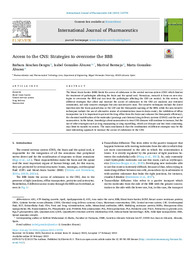Por favor, use este identificador para citar o enlazar este ítem:
https://hdl.handle.net/11000/34630Registro completo de metadatos
| Campo DC | Valor | Lengua/Idioma |
|---|---|---|
| dc.contributor.author | Sánchez-Dengra, Bárbara | - |
| dc.contributor.author | González Álvarez, Isabel | - |
| dc.contributor.author | Bermejo, Marival | - |
| dc.contributor.author | González Álvarez, Marta | - |
| dc.contributor.other | Departamentos de la UMH::Ingeniería | es_ES |
| dc.date.accessioned | 2025-01-16T18:13:36Z | - |
| dc.date.available | 2025-01-16T18:13:36Z | - |
| dc.date.created | 2023-02-18 | - |
| dc.identifier.citation | International Journal of Pharmaceutics Volume 636, 5 April 2023, 122759 | es_ES |
| dc.identifier.issn | 1873-3476 | - |
| dc.identifier.issn | 0378-5173 | - |
| dc.identifier.uri | https://hdl.handle.net/11000/34630 | - |
| dc.description.abstract | The blood–brain barrier (BBB) limits the access of substances to the central nervous system (CNS) which hinders the treatment of pathologies affecting the brain and the spinal cord. Nowadays, research is focus on new strategies to overcome the BBB and can treat the pathologies affecting the CNS are needed. In this review, the different strategies that allow and increase the access of substances to the CNS are analysed and extended commented, not only invasive strategies but also non-invasive ones. The invasive techniques include the direct injection into the brain parenchyma or the CSF and the therapeutic opening of the BBB, while the non-invasive techniques include the use of alternative routes of administration (nose-to-brain route), the inhibition of efflux transporters (as it is important to prevent the drug efflux from the brain and enhance the therapeutic efficiency), the chemical modification of the molecules (prodrugs and chemical drug delivery systems (CDDS)) and the use of nanocarriers. In the future, knowledge about nanocarriers to treat CNS diseases will continue to increase, but the use of other strategies such as drug repurposing or drug reprofiling, which are cheaper and less time consuming, may limit its transfer to society. The main conclusion is that the combination of different strategies may be the most interesting approach to increase the access of substances to the CNS. | es_ES |
| dc.format | application/pdf | es_ES |
| dc.format.extent | 12 | es_ES |
| dc.language.iso | eng | es_ES |
| dc.publisher | Elsevier | es_ES |
| dc.rights | info:eu-repo/semantics/openAccess | es_ES |
| dc.rights | Attribution-NonCommercial-NoDerivatives 4.0 Internacional | * |
| dc.rights.uri | http://creativecommons.org/licenses/by-nc-nd/4.0/ | * |
| dc.subject | blood–brain barrier | es_ES |
| dc.subject | central nervous system | es_ES |
| dc.subject | nanocarriers | es_ES |
| dc.subject | drug delivery | es_ES |
| dc.subject.other | CDU::6 - Ciencias aplicadas::62 - Ingeniería. Tecnología | es_ES |
| dc.title | Access to the CNS: Strategies to overcome the BBB | es_ES |
| dc.type | info:eu-repo/semantics/article | es_ES |
| dc.relation.publisherversion | https://doi.org/10.1016/j.ijpharm.2023.122759 | es_ES |

Ver/Abrir:
1-s2.0-S0378517323001795-main.pdf
1,41 MB
Adobe PDF
Compartir:
 La licencia se describe como: Atribución-NonComercial-NoDerivada 4.0 Internacional.
La licencia se describe como: Atribución-NonComercial-NoDerivada 4.0 Internacional.
.png)